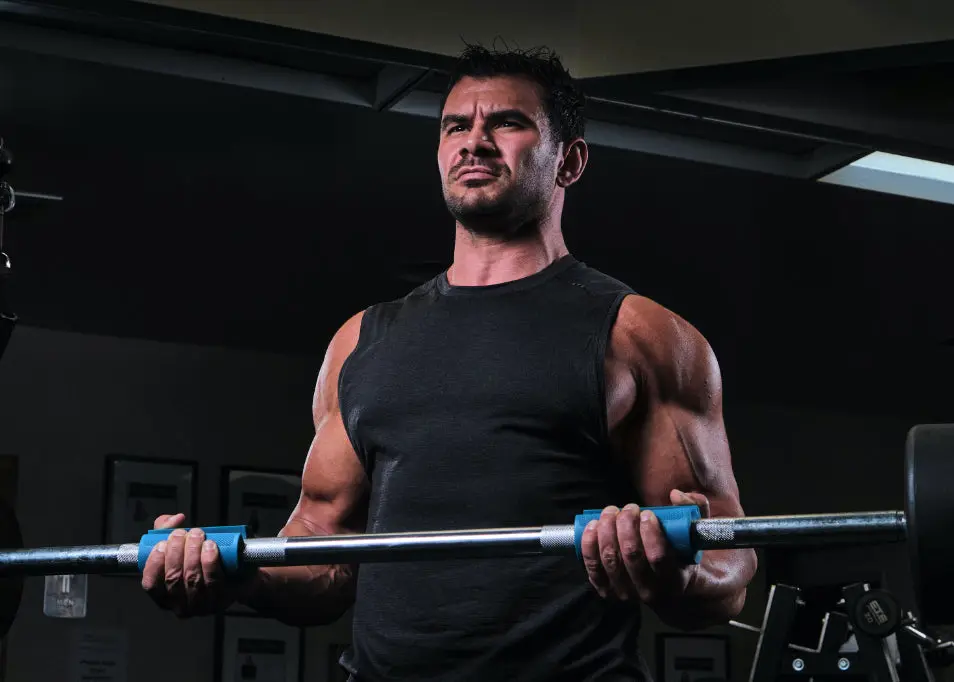Thick Bar (Fat Grip) Training for Forearm Size & Grip Strength: Unlocking Next-Level Arm Density
If you’ve ever seen a powerlifter or strongman with tree trunk forearms, you can bet they’ve spent time training with thick bars or Fat Gripz.Thick bar training isn’t a gimmick — it’s an old-school, brutally effective method to develop real-world grip strength, forearm density, and upper arm thickness that traditional barbell and dumbbell work can’t match.
By increasing the diameter of the handle, thick bar training forces your forearm flexors, extensors, and stabilizers to fire harder to maintain control.
This overloads the muscles and tendons of your lower arm in a way that rapidly builds strength, size, and endurance — while improving performance in every major lift.
Whether you use Fat Gripz, Axle Bars, or homemade thick handles, this form of training can transform your grip power, muscle detail, and overall arm development.
Let’s break down how and why thick bar training works, how to apply it safely and effectively, and the best ways to program it for forearm hypertrophy and grip mastery.
Muscles Worked
Primary Muscles:
- Forearm Flexors (Flexor Digitorum Profundus & Superficialis) – maintain the squeeze around thick bars.
- Brachioradialis – assists in elbow flexion and grip stabilization.
- Forearm Extensors – balance the increased flexion stress for joint stability.
Secondary Muscles:
- Biceps Brachii & Brachialis – assist during curling and pulling with thick grips.
- Deltoids & Trapezius – stabilize during heavy carries or presses.
- Finger Flexors & Intrinsics – develop powerful hand strength and endurance.
💡 Think of thick bar training as magnifying the difficulty of every lift — forcing your hands and forearms to work overtime just to hold on.
What Is Thick Bar (Fat Grip) Training?
Thick bar training involves performing standard strength exercises (curls, presses, pulls, carries) using bars, handles, or attachments that are thicker than the standard 1-inch diameter grip — typically 2 to 2.5 inches thick.
This can be achieved by:
- Using Fat Gripz or similar rubber adapters that slide onto standard bars or dumbbells.
- Training with axle bars (thick steel bars used in strongman events).
- Using specialty dumbbells or handles designed with oversized grips.
The thicker surface drastically increases the difficulty of maintaining grip, forcing your forearms to engage maximally on every rep.
Why Thick Bar Training Works
Thick bar training creates mechanical disadvantage — your fingers can’t fully wrap around the bar, so your forearms have to contract harder to maintain control.
Here’s why that’s a game-changer:
- Maximal Muscle Recruitment
Your forearms must contract harder to maintain tension on a wider surface. This skyrockets neural activation in the hands, wrists, and forearms.
- Enhanced Grip Endurance
Holding onto a thick bar builds fatigue resistance in the smaller muscles of the hand and wrist — translating to longer, stronger lifts.
- Increased Time Under Tension
Because thick bars slow down your rep speed and force better control, each lift increases time under tension, a proven driver of hypertrophy.
- Injury Prevention & Joint Health
Stronger grip and forearm muscles protect the wrists, elbows, and connective tissues from strain during heavy pressing or pulling.
- Crossover Benefits
Improved grip translates to better performance in deadlifts, pull-ups, rows, curls, and even pressing stability.
How to Incorporate Thick Bar Training
You can integrate thick bar work in several ways — as full exercises, accessory lifts, or grip finishers.
Option 1: Full Thick Bar Workouts
Perform major lifts using Fat Gripz or axle bars:
- Barbell Curl (Thick Bar)
- Dumbbell Press (Thick Handle)
- Deadlift or Row (Thick Bar)
- Farmer’s Carry (Fat Gripz Dumbbells)
Option 2: Accessory Sets
Use thick grips on your last 2–3 sets of pulling or curling exercises to overload your grip and forearms without sacrificing main lift volume.
Option 3: Dedicated Grip Finishers
After your main workout, perform short, intense sets focused solely on grip and forearm burn:
- Thick Bar Holds: 3×30 seconds
- Fat Grip Hammer Curls: 3×10–12
- Thick Bar Deadlift Hold: 3×20–30 seconds
Example Exercises Using Thick Bars
- Thick Bar Curl
- Hold a barbell or dumbbells with thick grips.
- Perform curls as normal, maintaining constant squeeze.
- Keep wrists neutral — avoid rolling them.
- Focus on control and full contraction.
🧠 This variation builds tremendous forearm fullness and bicep density.
- Thick Bar Deadlift Hold
- Load a barbell with moderate weight.
- Deadlift to lockout and hold for time.
- Aim for 20–45 seconds of tension.
🔥 Ideal for improving grip strength and preventing bar slippage during heavy lifts.
- Thick Bar Farmer’s Carry
- Hold a pair of thick-handled dumbbells or use Fat Gripz attachments.
- Walk 20–30 meters maintaining upright posture.
- Keep grip locked and shoulders packed.
💪 This builds crushing grip strength and serious forearm endurance.
- Thick Bar Pull-Up or Chin-Up
- Wrap Fat Gripz around the pull-up bar.
- Perform controlled reps without swinging.
- Focus on maintaining grip tension throughout.
⚙️ A challenging but effective upper-body movement for grip dominance.
- Thick Bar Press Variations
- Add Fat Gripz to dumbbell or barbell presses.
- Enhances shoulder and wrist stability under load.
🛡️ Excellent for improving joint integrity while still building pressing strength.
Programming Guidelines
For Forearm & Grip Hypertrophy
- Frequency: 2–3 times per week
- Volume: 3–4 sets per exercise
- Reps: 8–12 (controlled tempo)
- Rest: 60–90 seconds
For Grip Endurance & Strength
- Frequency: 2 times per week
- Duration: 20–45 second holds
- Intensity: Heavy but maintain form
- Rest: 90–120 seconds
For Performance Enhancement
- Use thick grips periodically (2–4-week blocks).
- Alternate with standard grip training for balance.
- Focus on compound lifts to maximize transfer.
Common Mistakes and Fixes
| Mistake | Issue | Fix |
| Using too much weight | Grip fails before muscles are trained | Start light and build tolerance |
| Overtraining grip | Leads to forearm strain | Limit to 2–3 sessions per week |
| Allowing bar to roll | Reduces activation | Squeeze hard and control tempo |
| Using straps | Defeats grip purpose | Avoid unless used for specific overload |
| Ignoring recovery | Forearms can over-fatigue | Stretch, massage, and rest properly |
Bodybuilder’s Training Strategies
💡 1. Start Small, Build Up
Begin with one or two thick bar movements per week to condition your hands and tendons.
💡 2. Prioritize Control Over Load
Focus on controlled tempo and constant tension — that’s where forearm growth happens.
💡 3. Use Contrast Training
Alternate sets of thick-bar curls with normal curls to activate fast-twitch fibers.
💡 4. Train the Extensors
Balance forearm strength by doing finger extensions with bands between thick bar sessions.
💡 5. Pair With Carries or Holds
Combine thick bar curls with Farmer’s Carries, Dead Hangs, or Plate Pinches for total grip development.
Advanced Applications
Fat Grip Partial Deadlifts
- Use a power rack to train grip strength from mid-shin to lockout.
- Focus on static holds, 15–20 seconds per rep.
Thick Handle Cable Attachments
- Add Fat Gripz to cable bars for curls and pushdowns.
- Intensifies forearm activation without new equipment.
Axle Bar Pulls or Rows
- The axle bar’s thick diameter challenges grip during heavy pulling.
- Excellent for strongman or power-focused athletes.
Recovery and Maintenance
Thick bar training can be taxing on the tendons and connective tissue of the wrist and hand.
To stay healthy and consistent:
✅ Warm up with wrist circles and light squeezes before training.
✅ Stretch forearms after every session (especially flexors).
✅ Massage with a lacrosse ball or roller to relieve tension.
✅ Avoid training grip to failure too often — overuse leads to tendinitis.
Sample Forearm Workout with Thick Bar Integration
- Thick Bar Curl: 3×10–12
2. Thick Bar Deadlift Hold: 3×30s
3. Farmer’s Carry (Thick Handle): 3×25m
4. Reverse Curl: 3×12
5. Finger Extensions (Rubber Band): 3×20
🔥 Finish with wrist stretches and 1 minute of hand gripper work.
Safety Tips
⚠️ Don’t jump to heavy axle bars right away — start with moderate thickness (1.75–2 inches).
⚠️ Maintain neutral wrist alignment — avoid excessive bending.
⚠️ If your forearms or elbows ache, reduce volume and frequency.
⚠️ Never let grip training compromise your main lifts — treat it as a supplement, not a replacement.
Why Every Lifter Should Use Thick Bar Training
- Builds functional grip strength that carries over to every major lift.
- Enhances forearm size, vascularity, and definition.
- Improves wrist stability for pressing and curling longevity.
- Boosts performance in deadlifts, rows, and pull-ups.
- Trains mental toughness — few exercises test your willpower like holding onto a thick bar.
Practical Takeaways
✅ Integrate thick bar training 2–3 times per week for best results.
✅ Focus on control, not load — grip fatigue is your growth signal.
✅ Use a mix of curls, holds, and carries for complete forearm development.
✅ Combine with extensor work and stretching to avoid imbalance.
✅ Over time, expect stronger lifts, bigger forearms, and unshakable grip strength.
Conclusion
Thick bar (Fat Grip) training is one of the most effective — yet underrated — tools for building forearm size, crushing grip strength, and upper arm density.
It adds a layer of intensity and functionality to every movement, transforming ordinary lifts into total-arm challenges.
Whether you’re curling, pulling, pressing, or carrying, thick bar training builds the kind of dense, granite-hard muscle that defines elite physiques. It’s simple, brutal, and incredibly rewarding — an old-school method that modern lifters should never overlook.
Train smart, stay consistent, and your handshake — and your forearms — will start commanding respect in no time.





